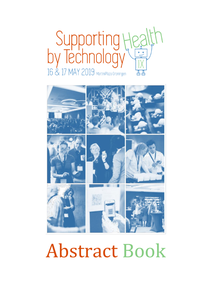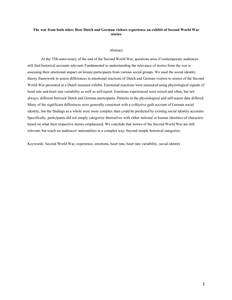To optimize performance, coaches and athletes are always looking for the right balance between training load and recovery. Therefore, closely monitoring of athletes is important. Heart rate recovery (HRR) after standardized sub maximal exercise has been proposed as a useful variable to monitor (Lamberts et al., 2004). However, it is well known that heart rate, next to biological variability, is influenced by several factors such as training load and psychosocial stress. So, the purpose was to look at individual variability in HRR from one week to another using the heart rate interval monitoring system (HIMS). Methods Eight elite Dutch female indoor hockey players (age: 23.9±3.91yr, length: 155.0±7.01cm, weight: 56.6±6.16kg) completed the HIMS two weeks in a row (Lamberts et al., 2004). The heart rate at the end of the last stage (HRend) was determined and the HRR was calculated one minute after the end of the last stage. Furthermore, training load and psychosocial stress and recovery were monitored using the Foster-method (1998) and the RESTQ-Sport (Nederhof et al., 2008), respectively. Results A strong correlation was found between the HRend from one week to the other (r=0.984 p.
DOCUMENT

The aim of this study was to investigate changes in heart rate during submaximal exercise as an index of cardiovascular function in older adults participating in the Groningen Active Living Model recreational sports programme who were sedentary or underactive at baseline. A repeated measurement design was conducted; 151 participants were included, providing 398 heart rate files over a period of 18 months. Multi-level analyses were conducted; growth and final models were developed. Significant decreases in mean heart rate over time were observed for all walking speeds. The covariates of sex and body mass index (BMI) were significantly related to mean heart rate at each walking speed, except for BMI at 7 km/h. No significant relationships were observed between energy expenditure for recreational sports activities and leisure-time physical activities and mean heart rate, except for energy expenditure for leisure-time physical activities at 7 km/h. From baseline to December 2002, decreases in predicted mean heart rate were 5.5, 6.0, 10.0, and 9.0 beats/min at walking speeds of 4, 5, 6, and 7 km/h; relative decreases ranged from 5.1 to 7.4%. Significant decreases in heart rate observed during submaximal exercise reflected a potential increase in cardiovascular function after 18 months of participation in the Groningen Active Living Model recreational sports programme.DOI:10.1080/02640410903008749
DOCUMENT

Because physical fitness and health are related to physical activity, it is important to gain an insight into the physical activity levels of persons with profound intellectual and multiple disabilities (PIMD). The purpose of this study was to examine heart rate patterns to measure the activity levels of persons with PIMD and to analyze these heart rate patterns according to participant characteristics, observed level of activity, days, and time of day. The heart rate patterns of 24 participants with PIMD were measured continuously using a heart rate monitor for 8 h·d for a period of 6 days. Physical activity levels were measured with questionnaires. Data were analyzed using multilevel analysis. The results indicate that the participants use only 32% of their heart rate reserve over 6 days. The intensity of heart rate reserve ranged from 1 to 62%. On a given day, wide ranges in heart rates between participants and within persons were observed. Between days, only small ranges in the heart rate were found. The participants could be grouped into 4 classes according to their heart rate. In addition, factors such as time of day, physical activity, and age are significantly related to heart rate patterns. In conclusion, this study is an important first step in exploring activity patterns based on heart rate patterns in persons with PIMD. The participants used relatively small fractions of their heart rate reserves. Time of day and age appear to have a considerable influence on heart rate patterns. The observed classes in heart rate patterns suggest that other probably more personal and psychosocial factors have significant influences on heart rate patterns, as well
MULTIFILE

The objective of this study is to investigate the heart rate (HR) accuracy measured at the wrist with the photoplethysmography (PPG) technique with a Fitbit Charge 2 (Fitbit Inc) in wheelchair users with spinal cord injury, how the activity intensity affects the HR accuracy, and whether this HR accuracy is affected by lesion level.
MULTIFILE

Occupational stress can cause all kinds of health problems. Resilience interventions that help employees deal with and adapt to adverse events can prevent these negative consequences. Due to advances in sensor technology and smartphone applications, relatively unobtrusive self-monitoring of resilience-related outcomes is possible. With models that can recognize intra-individual changes in these outcomes and relate them to causal factors within the employee’s own context, an automated resilience intervention that gives personalized, just-in-time feedback can be developed. The Wearables and app-based resilience Modelling in employees (WearMe) project aims to develop such models. A cyclical conceptual framework based on existing theories of stress and resilience is presented, as the basis for the WearMe project. The included concepts are operationalized and measured using sleep tracking (Fitbit Charge 2), heart rate variability measurements (Elite HRV + Polar H7) and Ecological Momentary Assessment (mobile app), administered in the morning (7 questions) and evening (12 questions). The first (ongoing) study within the WearMe project investigates the feasibility of the developed measurement cycle and explores the development of such models in social studies students that are on their first major internship. Analyses will target the development of both within-subject (n=1) models, as well as between-subjects models. The first results will be shared at the Health By Tech 2019 conference in Groningen. If successful, future work will focus on further developing these models and eventually exploring the effectiveness of the envisioned personalized resilience system.
DOCUMENT

The problem addressed in this report is to verify the possibility of using an optical sensor in the SaxShirt in order to extract the heart rate. There are specifically three questions that we try to address. 1) How is it possible to extract heart rate (BPM) from the optical sensor? 2) Is it possible to use the sensor for extracting BPM during movement? 3) Is the heart rate measured in this way useful for measuring other higher-level parameters such as heart rate coherence and heart rate variability? For this purpose, we have performed tests with the sensor placed on different spots and the data was analyzed to see if heart rate can be extracted from the sensor measurements.
MULTIFILE

The aim of this study was to investigate changes in heart rate during submaximal exercise as an index of cardiovascular function in older adults participating in the Groningen Active Living Model recreational sports programme who were sedentary or underactive at baseline. A repeated measurement design was conducted; 151 participants were included, providing 398 heart rate files over a period of 18 months. Multi-level analyses were conducted; growth and final models were developed. Significant decreases in mean heart rate over time were observed for all walking speeds. The covariates of sex and body mass index (BMI) were significantly related to mean heart rate at each walking speed, except for BMI at 7 km h71. No significant relationships were observed between energy expenditure for recreational sports activities and leisure-time physical activities and mean heart rate, except for energy expenditure for leisure-time physical activities at 7 km h71. From baseline to December 2002, decreases in predicted mean heart rate were 5.5, 6.0, 10.0, and 9.0 beats min71 at walking speeds of 4, 5, 6, and 7 km h71; relative decreases ranged from 5.1 to 7.4%. Significant decreases in heart rate observed during submaximal exercise reflected a potential increase in cardiovascular function after 18 months of participation in the Groningen Active Living Model recreational sports programme.
DOCUMENT
Low heart rate variability (HRV) is related to health problems that are known reasons for sick-leave or early retirement. A 1-minute-protocol could allow large scale HRV measurement for screening of health problems and, potentially, sustained employability. Our objectives were to explore the association of HRV with measures of health. Cross-sectional design with 877 Dutch employees assessed during a Workers’ Health Assessment. Personal and job characteristics, workability, psychological and mental problems, and lifestyle were measured with questionnaires. Biometry was measured (BMI, waist circumference, blood pressure, glucose, cholesterol). HRV was assessed with a 1-minute paced deep-breathing protocol and expressed as mean heart rate range (MHRR). A low MHRR indicates a higher health risk. Groups were classified age adjusted for HRV and compared. Spearman correlations between raw MHRR and the other measures were calculated. Significant univariable correlations (p < 0.05) were entered in a linear regression model to explore the multivariable association with MHRR. Age, years of employment, BMI and waist circumference differed significantly between HRV groups. Significant correlations were found between MHRR and age, workability, BMI, waist circumference, cholesterol, systolic and diastolic blood-pressure and reported physical activity and alcohol consumption. In the multivariable analyses 21.1% of variance was explained: a low HRV correlates with aging, higher BMI and higher levels of reported physically activity. HRV was significantly associated with age, measures of obesity (BMI, waist circumference), and with reported physical activity, which provides a first glance of the utility of a 1-minute paced deep-breathing HRV protocol as part of a comprehensive preventive Workers’ Health Assessment.Open Access This article is distributed under the terms of the Creative Commons Attribution 4.0 International License (http://creat ivecommons .org/licen ses/by/4.0/), which permits unrestricted use, distribution, and reproduction in any medium, provided you give appropriate redit to the original author(s) and the source, provide a link to the Creative Commons license, and indicate if changes were made.
MULTIFILE

MULTIFILE
At the 75th anniversary of the end of the Second World War, questions arise if contemporary audiences still find historical accounts relevant. Fundamental to understanding the relevance of stories from the war is assessing their emotional impact on leisure participants from various social groups. We used the social identity theory framework to assess differences in emotional reactions of Dutch and German visitors to stories of the Second World War presented at a Dutch museum exhibit. Emotional reactions were measured using physiological signals of heart rate and heart rate variability as well as self-report. Emotions experienced were mixed and often, but not always, different between Dutch and German participants. Patterns in the physiological and self-report data differed. Many of the significant differences were generally consistent with a collective guilt account of German social identity, but the findings as a whole were more complex than could be predicted by existing social identity accounts. Specifically, participants did not simply categorize themselves with either national or human identities of characters based on what their respective stories emphasized. We conclude that stories of the Second World War are still relevant, but touch on audiences’ nationalities in a complex way, beyond simple historical categories.
DOCUMENT
